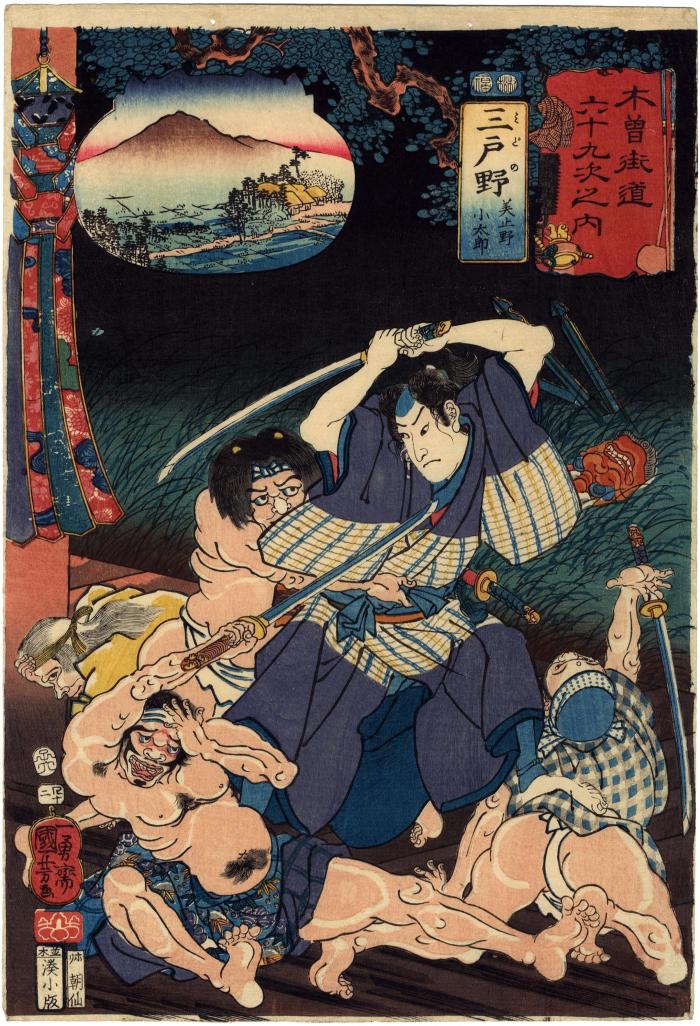Utagawa Kuniyoshi (歌川国芳) (artist 11/15/1797 – 03/05/1861)
Midono (三戸野): Midono Kotarō (美止野小太郎) from the series Sixty-nine Stations of the Kisokaidō Road (Kisokaidō rokujūkyū tsugi no uchi - 木曾街道六十九次之内)
06/1852
10.125 in x 14.75 in (Overall dimensions) Japanese woodblock print
Signed: Ichiyūsai Kuniyoshi ga
一勇斎国芳画
Publisher: Minatoya Kohei
(Marks 332 - seal 24-075)
Carver: Hori Chōsen (ホ[リ]朝仙)
Date: 6/1852
Censor seals: Fuku and Muramatsu
Number 42
Museum of Fine Arts, Boston
British Museum
Tokyo Metropolitan Library
Google maps
Hiroshige Museum of Art
Musée Cernuschi "Midono Kotarō, whose surname is identical to the name of the forty-second station, is a character in the novel The Secret History of Oguri Hangan (Oguri Hangan gaiden), published in installments from 1813 to 1825. The book is one of many stories and plays dealing with the life of Oguri Hangan, a real warrior of the fifteenth century who was said to be such a superb horseman that he could make a horse stand on a Go board. In the romantic legend attached to his name, Hangan falls in love with a beautiful young woman named Terute-hime, but her father opposes the match. He poisons Hangan, who nearly dies and is temporarily crippled as a result. With the help of his loyal followers, Hangan is eventually reunited with Terute-hime and is healed by a miracle at the Kumano Shrine.
Midono Kotarō is one of the ten most trusted retainers of Oguri Hangan. In this scene, from part 13 of the book, Kotarō has become separated from Terute-hime and takes shelter one night at a ruined temple. He discovers, to his surprise, that someone else is already sleeping there: a gang of bandits who, in order to look even more ferocious, have disguised themselves as the various denizens of a Buddhist hell. Kotarō awakens them and fights the whole gang at once; he is such a fine swordsman that he easily defeats them.
In the print, the bandit grabbing Kotarō's belt has his hair arranged to resemble the horns of a demon. The white-haired figure at the left is impersonating Datsuiba, the hag who takes away the clothing of sinners entering hell. A masklike face that may be the broken head of a guardian figure lies in the grass. The series title border is decorated with amix of weapons and Buddhist utensils, and the rounded outline of the inset landscape in the shape of a mokugyō (literally 'wooden fish'), a percussion instrument used in buddhist temples."
Illustrated in and quoted from: Utagawa Kuniyoshi: The Sixty-nine Stations of the Kisokaidō by Sarah E. Thompson, Pomegranate Communications, Inc., 2009, pages 100-101, no. 42.
****
Listed, but unillustrated, in Japanese Woodblock Prints: A Catalogue of the Mary A. Ainsworth Collection, by Roger Keyes, p. 192, #529. The carver is referred to here as Hori Asa Sen.
Minatoya Kohei (湊屋小兵衛) (publisher)
landscape prints (fūkeiga 風景画) (genre)
Oguri Hangan (小栗判官) (role)
